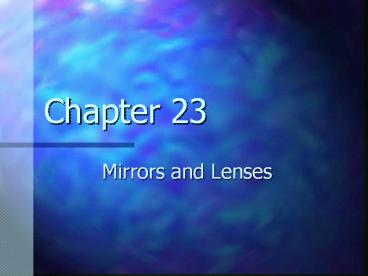Mirrors and Lenses - PowerPoint PPT Presentation
1 / 20
Title: Mirrors and Lenses
1
Chapter 23
- Mirrors and Lenses
2
Types of Images for Mirrors and Lenses
- A real image is one in which light actually
passes through the image point - Real images can be displayed on screens
- A virtual image is one in which the light does
not pass through the image point - The light appears to come (diverge) from that
point - Virtual images cannot be displayed on screens
3
More About Images
Image distance
Object distance
- To find where an image is formed, it is always
necessary to follow at least two rays of light as
they reflect from the mirror. The image formed by
the flat mirror is a virtual image
4
Flat Mirror
pq!
- Simplest possible mirror
- Properties of the image can be determined by
geometry - One ray starts at P, follows path PQ and reflects
back on itself - A second ray follows path PR and reflects
according to the Law of Reflection
5
Properties of the Image Formed by a Flat Mirror
- The image is as far behind the mirror as the
object is in front - p q
- The image is unmagnified, M1
- The image is virtual
- The image is upright
- It has the same orientation as the object
- There is an apparent left-right reversal in the
image
6
Application Day and Night Settings on Car
Mirrors
- With the daytime setting, the bright beam of
reflected light is directed into the drivers
eyes - With the nighttime setting, the dim beam (D) of
reflected light is directed into the drivers
eyes, while the bright beam goes elsewhere
7
23.2 Spherical Mirrors
- A spherical mirror has the shape of a segment of
a sphere - A concave spherical mirror has the silvered
surface of the mirror on the inner, or concave,
side of the curve - A convex spherical mirror has the silvered
surface of the mirror on the outer, or convex,
side of the curve
8
Concave Mirror, Notation
- The mirror has a radius of curvature of R
- Its center of curvature is the point C
- Point V is the center of the spherical segment
- A line drawn from C to V is called the principle
axis of the mirror - I is the image point
9
Focal Length
- If an object is very far away, then p?? and 1/p ?
0 - qR/2
- Incoming rays are essentially parallel
- In this special case, the image point is called
the focal point - The distance from the mirror to the focal point
is called the focal length - The focal length is ½ the radius of curvature
f R/2
10
Focal Length Shown by Parallel Rays
11
23.3 Convex Mirrors
- A convex mirror is sometimes called a diverging
mirror - The rays from any point on the object diverge
after reflection as though they were coming from
some point behind the mirror - The image is virtual because it lies behind the
mirror at the point where the reflected rays
appear to originate - In general, the image formed by a convex mirror
is upright, virtual, and smaller than the object
12
Image Formed by a Convex Mirror
13
Ray Diagrams
- A ray diagram can be used to determine the
position and size of an image - They are graphical constructions which tell the
overall nature of the image - They can also be used to check the parameters
calculated from the mirror and magnification
equations
14
Drawing A Ray Diagram
- To make the ray diagram, you need to know
- The position of the object
- The position of the center of curvature
- Three rays are drawn
- They all start from the same position on the
object - The intersection of any two of the rays at a
point locates the image - The third ray serves as a check of the
construction
15
The Rays in a Ray Diagram
- Ray 1 is drawn parallel to the principle axis and
is reflected back through the focal point, F - Ray 2 is drawn through the focal point and is
reflected parallel to the principle axis - Ray 3 is drawn through the center of curvature
and is reflected back on itself
1
3
2
16
Notes About the Rays
- The rays actually go in all directions from the
object - The three rays were chosen for their ease of
construction - The image point obtained by the ray diagram must
agree with the value of q calculated from the
mirror equation
17
Ray Diagram for Concave Mirror, p gt R
- The image is real
- The image is inverted
- The image is smaller than the object
18
Ray Diagram for a Concave Mirror, p lt f
- The image is virtual
- The image is upright
- The image is larger than the object
19
Ray Diagram for a Convex Mirror
- The image is virtual
- The image is upright
- The image is smaller than the object
20
Notes on Images
- With a concave mirror, the image may be either
real or virtual - When the object is outside the focal point, the
image is real - When the object is at the focal point, the image
is infinitely far away (to the left in the
previous diagrams) - When the object is between the mirror and the
focal point, the image is virtual - With a convex mirror, the image is always virtual
and upright - As the object distance increases, the virtual
image gets smaller































